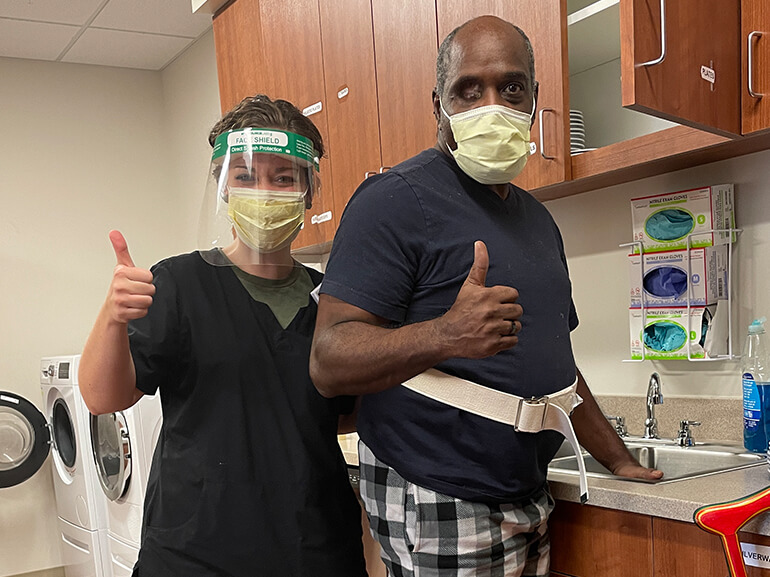Leonard's Story*

Leonard Loftin, 58, lives in Akron, Ohio with his son, Jarvis and daughter, Taylor and works full-time with senior citizens helping them to complete their daily chore work and living activities.
In October, Leonard had just gotten off work and decided to take a nap before he had to pick Taylor up from her job. When Taylor called, Leonard noticed a tingling in his left arm and leg. He assumed he just slept on them funny. He got in his car to go pick up Taylor, but he ended up driving past her work and got lost. He pulled the car over and launched his navigation system to get back on track. When he made it to his destination, Taylor immediately noticed something was off. She drove them back home and suggested her dad lay down. However, when Leonard woke up, he was unable to put any weight on the lower left half of his body. That’s when Taylor took him straight to the emergency department at a local hospital.
After blood work, CT scans and other tests, doctors determined Leonard had a stroke. After a week in the hospital, he was ready for the next step in his recovery at Cleveland Clinic Rehabilitation Hospital, Edwin Shaw.
When Leonard arrived at Edwin Shaw, he was still experiencing weakness on the left side of his body, disorientation and slight cognitive deficits. His goals included being able to walk without assistance, use his left arm proficiently and gain back 90 -95 percent of his previous function. He began a therapy regimen to help achieve those goals.
In physical therapy, Leonard focused on being able to walk again. When he first started, the weakness in his left leg was so severe that his knees would buckle when he stood, and he required the assistance of three people to take a single step with the parallel bars. Leonard responded well to step training using a body-weight support harness over a treadmill. He enjoyed being challenged with more difficult balance activities. Prior to his stroke, Leonard enjoyed cycling and working out, so therapists incorporated that into his therapy sessions. Leonard also participated in the hospital’s stroke support group, allowing him to engage with other stroke survivors and learn about their recovery journey.
Leonard’s occupational therapists worked with him on regaining function in his left arm and becoming as independent as possible in his daily activities such as bathing, dressing, toileting and homemaking skills. With the help of therapists, Leonard showered several times a week -- initially requiring a significant amount of assistance and reminders of strategies from therapists. With enough repetition and hard work, he increased his independence daily, eventually being able to complete all of his self-care tasks without physical assistance at all. He also completed daily mirror therapy, which involves using a mirror to provide visual feedback and help the patient to move their weak arm. Leonard also utilized the Armeo Spring, a spring-loaded device that provides support to a patient's weak arm. Leonard did extra therapy tasks outside of his normal therapy sessions to make sure he regained as much function as possible in his arm. His persistence paid off and over time he was able to do things like hold his deodorant with his left hand and put it on without any help.
Leonard was highly motivated to return home to his family and continue caring for Jarvis, who has autism. One of his biggest goals for speech therapy was to be able to fill out paperwork related to Jarvis’s care. Leonard suffered significant visual impairments due to a combination of the stroke and previous right eye removal due to melanoma. Combined, these deficits made it very difficult for Leonard to locate and comprehend written information. However, he was highly motivated to return to caring for Jarvis, which kept him focused on completing various visual-spatial tasks and mock applications to improve his reading skills. Additional strategies and exercises were also used to help with short-term memory impairments.
When Leonard first arrived, he struggled with repeatedly biting the inside of his mouth when eating. His speech therapists help him combat this by teaching him exercises that increased the muscle strength in his face and lips. Leonard consistently completed these exercises daily and over time was able to chew and swallow a regular textured diet without any difficulty or pain.
Leonard recalls a moment of hope when he was feeling particularly discouraged. “Something in my mind told me to move my arm,” said Leonard. “I looked down and it started moving. Then everything else fell into place. My leg started to move and I could do exercises to promote even more mobility.”
Leonard’s family provided encouragement to get better and return home. Taylor was there for him every step of the process taking care of the house, bills and anything else Leonard needed. She also brought in their dog for a visit, which made Leonard’s spirits soar. Leonard’s oldest daughter lives in Chicago but provided emotional support, which made him very grateful.
After 30 days, Leonard was ready to return home, nearly independent in all activities of daily living and walking. He was looking forward to sitting on his own couch, watching TV with his dog curled up next to him and eating good food. He also planned to start an outpatient program to continue the progress he made at Edwin Shaw.
His parting advice: “Don't give up. You can be whole again.”